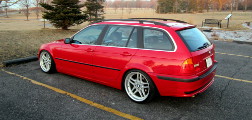i have a pair of speakers i'm thinking about installing in the rear to add some bass fill. it's not gonna add much, but it should help a bit. at least better than not having them powered. i don't want to add the weight of a 2nd amp, 10" sub, and box.
2 of the 4 channels on my amp are unused so my idea is to bridge those channels and connect my 2 speakers in series. they are 4-ohm speakers so that will make the total impedence 8-ohms.
my amp doesn't have any crossovers so i'll need a bandpass filter, 100-500hz . it doesn't look all that complicated to build a passive bandpass crossover (and maybe a little fun too), but i'm a little confused. i'm assuming i should buy capacitors and coils meant for 8-ohms. so by my calculations for a 12db bandpass crossover i'll need 18.01mH and 140.63pF for the highpass and 3.6mH and 28.13pF for the lowpass
am i on the right track?
2 of the 4 channels on my amp are unused so my idea is to bridge those channels and connect my 2 speakers in series. they are 4-ohm speakers so that will make the total impedence 8-ohms.
my amp doesn't have any crossovers so i'll need a bandpass filter, 100-500hz . it doesn't look all that complicated to build a passive bandpass crossover (and maybe a little fun too), but i'm a little confused. i'm assuming i should buy capacitors and coils meant for 8-ohms. so by my calculations for a 12db bandpass crossover i'll need 18.01mH and 140.63pF for the highpass and 3.6mH and 28.13pF for the lowpass
am i on the right track?



Comment